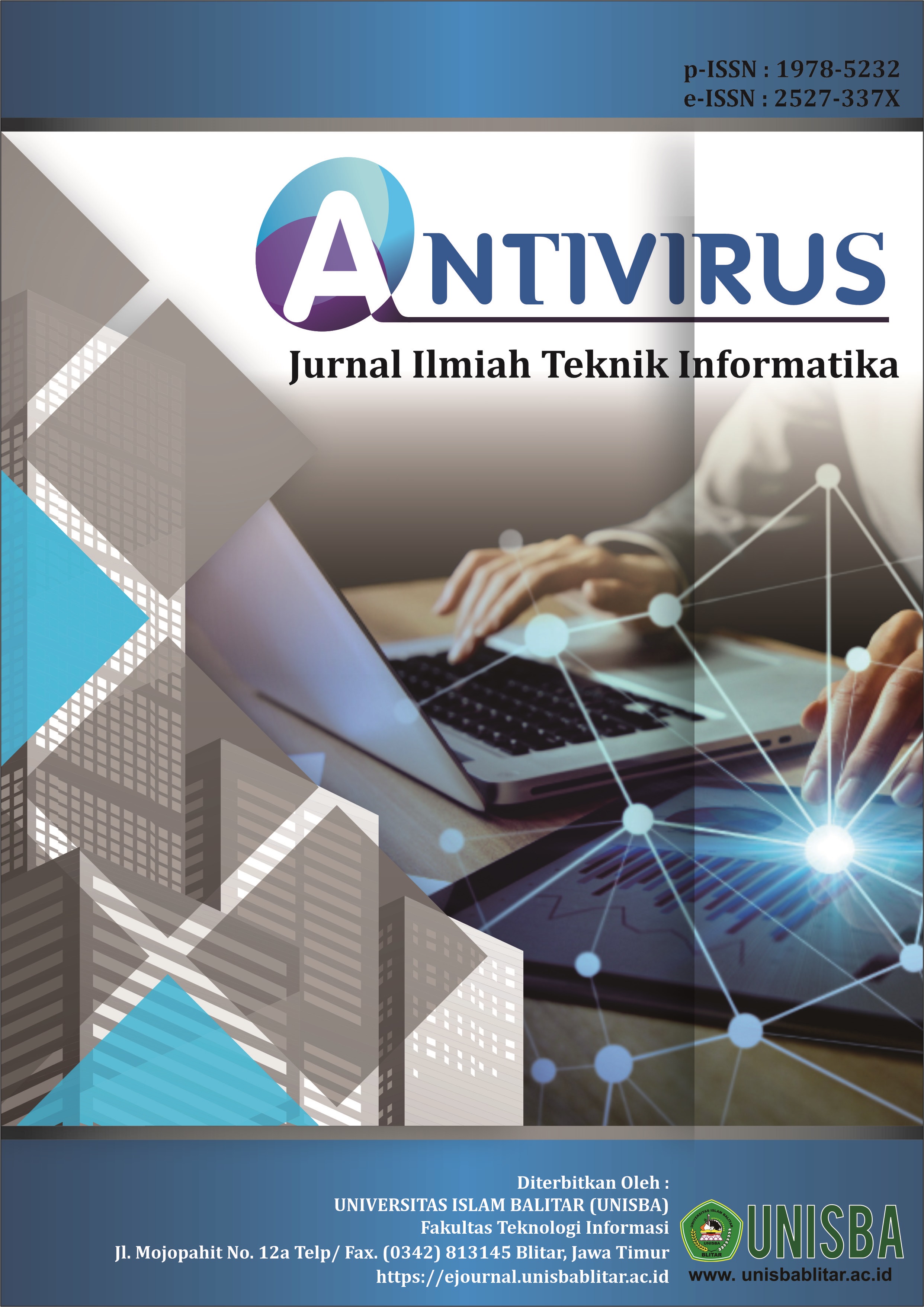ANALYSIS OF THE USE OF TEMPERATURE AND HUMIDITY SENSORS FOR ARDUINO-BASED GREENHOUSE ENVIRONMENT MONITORING
DOI:
https://doi.org/10.35457/antivirus.v16i2.2512Keywords:
Greenhouse, DHT 11 sensor, YL 69 Sensor, Arduino UNOAbstract
Green House is a construction building that functions to manipulate environmental conditions to create the desired environmental conditions in order to optimize plant maintenance, environmental conditioning carried out in the greenhouse includes temperature and humidity regulation, soil temperature and humidity regulation and good watering. The problem that occurs is the uneven distribution of air and soil temperature and humidity in all greenhouse areas which will ultimately affect plant growth in that area. This can be overcome by adding smart devices to the greenhouse. Analysis of temperature and humidity in the greenhouse aims to maximize the microclimate for plant growth. The analysis was carried out by measuring the conditions of temperature, air humidity and soil moisture without using automatic environmental temperature and humidity control devices. Then an analysis of environmental conditions is carried out by adding sensors and adding sprayers and fans connected to sensors measuring soil and air temperature and humidity. In this study used temperature and humidity sensors air DHT11, soil moisture sensor YL 69. The sensor is connected to the Arduino UNO microcontroller to carry out commands to the sprayer and fan. Before designing an automation system, an analysis is carried out on the range of fans and sprayers used. From the analysis carried out, the greenhouse area is divided into 8 measurement lines. Based on the research that has been done, it can be concluded that by using automatic temperature and humidity control devices for air and soil, the distribution of temperature and humidity becomes more pronounced, the resulting microclimate can support plant growth. Before the automation, the distribution of the greenhouse microclimate was not evenly distributed at every point and every time, whereas after the automation, the distribution became even. Optimization can be done even better if you pay attention to the needs of plants based on the type of plant being cultivated.
Downloads
References
O. Melo, "Komputerisasi Smart Greenhouse untuk Budidaya Tanaman Bunga Krisan," p. 18, 2012.
M. Munir, "Rancangan smart greenhouse dengan teknologi mobile untuk efisiensi tenaga, biaya, dan waktu dalam pengelolaan tanaman," UNS Surakarta, Surakarta, 2016.
P. Al-Humairi, "A Smart Automated Greenhouse: Soil Moisture, Temperature Monitoring and Automatic Water Supply System (Peaty, Loam and Silty)," in IEEE Conference on Sustainable Utilization and Development in Enginering and Technologies, 2019.
P. Telaumbanua, "Rancang bangun aktuator pengendali iklim mikro di dalam greenhouse untuk pertumbuhan tanaman sawi," UNG, Gorontalo, 2014.
Q. Gupta, "Multi-sensor integrated system for wireless monitoring of greenhouse environment," in IEEE Sensors Application Simposium (SAS), 2018.
Diansari, "Pengaturan suhu, kelembaban, waktu pemberian nutrisi dan waktu pembuangan air untuk pola cocok tanam hidroponik berbasis mikrokontroler AVR ATMega 8535," 2008.
A. Sari, "Analisis Distribusi Suhu dalam Bangunan Greenhouse Tunnel Berventilasi Ganda," Binus, Bogor, 2008.
Inayah, "Analisis Lingkungan Dalam Bangunan Greenhouse Tipe Tunnel yang Telah Dimodifikasi di PT. Alam Indah Bunga Nusantara, Cipanas, Cianjur," Cianjur, 2007.
W. Ambarwati, "Design and Prototype Development of Internet of Things for Greenhouse Monitoring System," in International Seminar on Research of Informaton Technology and Intelligent System, 2020.
B. &. Calvin, "Indoor Plants," New York, 1987.
Y. A. Amelia, "Perancangan sistem monitoring suhu, kelembaban dan titik embun udara secara realtime menggunakan mkrokontroler arduino dengan logika fuzzy yang dapat diakses melalui internet.," 2013.
I. Wijaya, "Auto Tuning PID berbasis metode Ziegles-Nichlos menggunakan Mikrokontroler AT89552 pada Pengendali Suhu," 2010.
L. Hui, "Greenhouse CFD Simulation for Searching the Sensor Optimal Placemnet.," 2002.
Downloads
Published
Issue
Section
License
Authors who publish with this journal agree to the following terms:
- Copyright on any article is retained by the author(s).
- Author grant the journal, right of first publication with the work simultaneously licensed under a Creative Commons Attribution License that allows others to share the work with an acknowledgement of the work’s authorship and initial publication in this journal.
- Authors are able to enter into separate, additional contractual arrangements for the non-exclusive distribution of the journal’s published version of the work (e.g., post it to an institutional repository or publish it in a book), with an acknowledgement of its initial publication in this journal.
- Authors are permitted and encouraged to post their work online (e.g., in institutional repositories or on their website) prior to and during the submission process, as it can lead to productive exchanges, as well as earlier and greater citation of published work.
- The article and any associated published material is distributed under the Creative Commons Attribution-ShareAlike 4.0 International License











